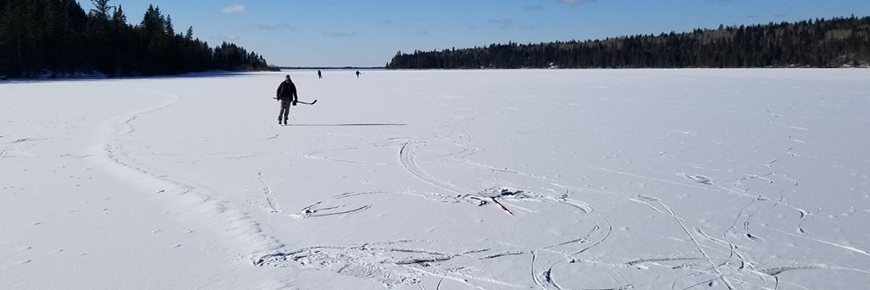
Activities on frozen water bodies
Riding Mountain National Park
Ice skating, ice fishing, kite boarding, skiing and snowshoeing are all popular winter activities in the park.
Many environmental factors affect the thickness of the ice. If you choose to skate on natural ice, you do so at your own risk. The recommended ice thickness is 15 cm for walking or skating alone and 20 cm for skating parties or games.
From The Canadian Red Cross Ice Safety
Many factors affect ice thickness, including type of water, location, the time of year and other environmental factors such as:
- water depth and size of body of water
- currents and other moving water
- chemicals including salt
- fluctuations in water levels
- logs, rocks and docks absorbing heat from the sun
- changing air temperature
The colour of ice may be an indication of its strength:
- Clear blue ice is strongest.
- White opaque or snow ice is half as strong as blue ice. Opaque ice is formed by wet snow freezing on the ice.
- Grey ice is unsafe. The grayness indicates the presence of water.
Ice thickness should be:
- 15 cm for walking or skating alone.
- 20 cm for skating parties or games.
If you get into trouble on ice and you're by yourself:
- Call for help.
- Resist the immediate urge to climb back out where you fell in. The ice is weak in this area.
- Use the air trapped in your clothing to get into a floating position on your stomach.
- Reach forward onto the broken ice without pushing down. Kick your legs to push your torso on the ice.
- When you are back on the ice, crawl on your stomach or roll away from the open area with your arms and legs spread out as far as possible to evenly distribute your body weight. Do not stand up! Look for shore and make sure you are going in the right direction.
Rescuing another person from ice can be dangerous. The safest way to perform a rescue is from shore.
- Call for help. Consider whether you can quickly get help from trained professionals (police, fire fighters or ambulance) or bystanders.
- Check if you can reach the person using a long pole or branch from shore – if so, lie down and extend the pole to the person.
- If you go onto ice, wear a PFD and carry a long pole or branch to test the ice in front of you. Bring something to reach or throw to the person (e.g. pole, weighted rope, line or tree branch).
- When near the break, lie down to distribute your weight and slowly crawl toward the hole.
- Remaining low, extend or throw your emergency rescue device (pole, rope, line or branch) to the person.
- Have the person kick while you pull them out.
- Move the person to a safe position on shore or where you are sure the ice is thick. Signal for help.
Parks Canada recommends:
- Checking the cracks in the ice to determine the depth of the ice: minimum of 15 cm thick.
- Wearing PFD's while skating if you are uncertain about ice thickness.
- Carrying some rope to help reach someone, and ice picks to help pull yourself out.
- Calling 911 or 1-877-852-3100 in case of EMERGENCY.
If you are going to a remote area, tell someone you trust exactly where your group is going and when you plan to return, and any other pertinent information that will assist search and rescue personnel if you do not return as planned.
Related links
- Important bulletins
- Top tips to respect wildlife and stay safe
- Evacuation guide
- AdventureSmart
- Automated External Defibrillator (AED) locations
- Winter Visitor Safety
- Ticks and Lyme disease
- The Do’s and Don’ts of Photographing Wildlife
- Poison ivy
- Swimmer's itch
- Use of drones at Parks Canada places
- Weather
- Road conditions
- Date modified :